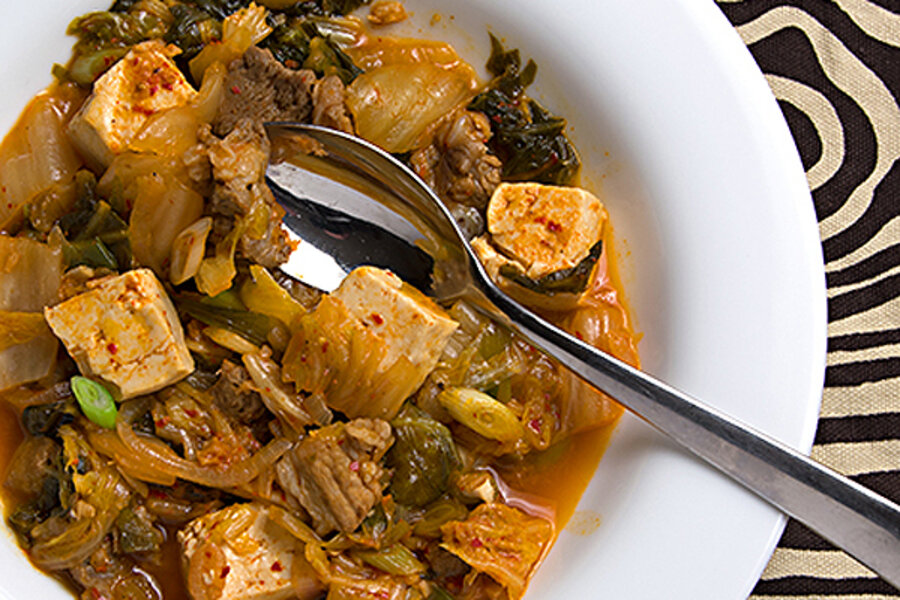Kimchi soup with pork belly and tofu
Loading...
Compared to Boston and other points east, we’re not having a bad winter in Chicago. But that doesn’t mean it isn’t getting to us. Multiple days of mostly single digit temperatures and sub-zero windchills have gotten old. And then there were the unexpected snow squalls Sunday, wrecking our plans for the day and causing a 38-car accident on a downtown expressway. It was time for some serious comfort food.
In our kitchen, winter comfort food is often solid American cooking. Stews, roast chickens, pot roasts, big pots of chili. The chili notwithstanding, any herbs and spices tend to nod toward European cuisine. Thyme, tarragon, herbes de Provence, bay leaves...
Based on a traditional Korean dish, Kimchi soup with pork belly and tofu is just as comforting as those dishes – hearty, warm and satisfyingly slurpy. But it also packs big, tangy, pungent flavor and a decent amount of heat. At its heart is kimchi, fermented vegetables (most often Napa cabbage), an absolute staple of Korean cooking. Gochujang, or red pepper paste, not only provides fire – made from red chiles, glutinous rice, fermented soybeans and salt – it adds a savory, pungent umami of its own.
The pork belly is more of a flavoring here than the lead player. It offers up tender/chewy bits to complement the crunchy kimchi and the silky tofu. It also provides all the cooking fat you need, rendering out as you brown the meat. No oil required for this recipe.
The hardest part of making Kimchi soup with pork belly and tofu will probably be finding the ingredients. But as Korean cuisine continues to grow in popularity, shopping is getting easier. In Chicago, we’re blessed with a number of Korean supermarkets, but many Asian markets carry kimchi. If you can’t find red pepper paste, Sriracha will do in a pinch.
Kimchi soup with pork belly and tofu
Serves 2 as a main course, with leftovers (maybe)
1/2 pound pork belly (skin removed), thinly sliced (see Kitchen Notes)
3 large garlic cloves, minced
1 tablespoon minced fresh garlic
1 tablespoon soy sauce
Freshly ground black pepper
1 small onion, halved and sliced into thin half moons
2 cups kimchi, chopped
1/2 cup kimchi liquid (from the kimchi jar)
1-1/2 cups water
1 tablespoon mirin (optional—see Kitchen Notes)
2 teaspoons Korean red pepper paste or to taste (gochujang—see Kitchen Notes)
8 ounces soft or silky tofu, cubed
1 tablespoon unsalted butter, sliced into 3 pieces
2 scallions, thinly sliced on the diagonal
Salt, if needed
1. Mix pork belly, garlic, ginger, and soy sauce in a bowl and set aside to marinate while you prep the other ingredients, up through cubing the tofu. Heat a heavy pot or Dutch oven over medium flame – give it time to get plenty hot. Add the pork belly and cook, stirring occasionally, until the fat begins to render, 3 minutes or so. Season generously with black pepper. Add onion to the pot and cook until just softened and translucent, stirring frequently, about 2 minutes.
2. Add kimchi, kimchi liquid and water to the pot. Stir to combine, scraping up any browned bits. Stir in mirin and hot pepper paste and bring pot to a boil. Add tofu to pot, stirring gently to avoid breaking up cubes. Reduce heat and simmer uncovered for 20 minutes, occasionally stirring gently.
3. Add butter pats to pot, stirring into liquid as they melt. Remove from heat. Sprinkle scallions over soup and stir one last time. Taste and adjust seasoning with salt, if needed. Spoon into shallow bowls and serve.
Kitchen Notes
Slicing pork belly. Once mainly used in Asian cuisines (or in the making of bacon), this meaty, fatty delight has gained wide acceptance (sometimes on an almost fanatical level) from chefs and home cooks everywhere. If you don’t find it properly pre-sliced (to about 1/4-inch thick), freeze it for about 15 minutes before slicing. It will firm up and slice more easily. Also, use a very sharp knife (but you always do, don’t you?). If you can’t find pork belly, substitute fatty pork shoulder or a pork chop. Don’t use cured bacon of any kind – too salty, too dried.
How much red pepper paste? Follow your taste buds – and those of your fellow diners. Start with 1 teaspoon, then add more. Also, if you plan to cook ahead and refrigerate to have the next day, be aware that it will be hotter on day two. Not sure why this happens, but it does.
Looking for ways to use any extra kimchi? One of the best uses I know is Marion’s kimchi pancake with chicken.
Related post on Blue Kitchen: Miso Braised Pork Shoulder: Because nothing comforts you like umami






